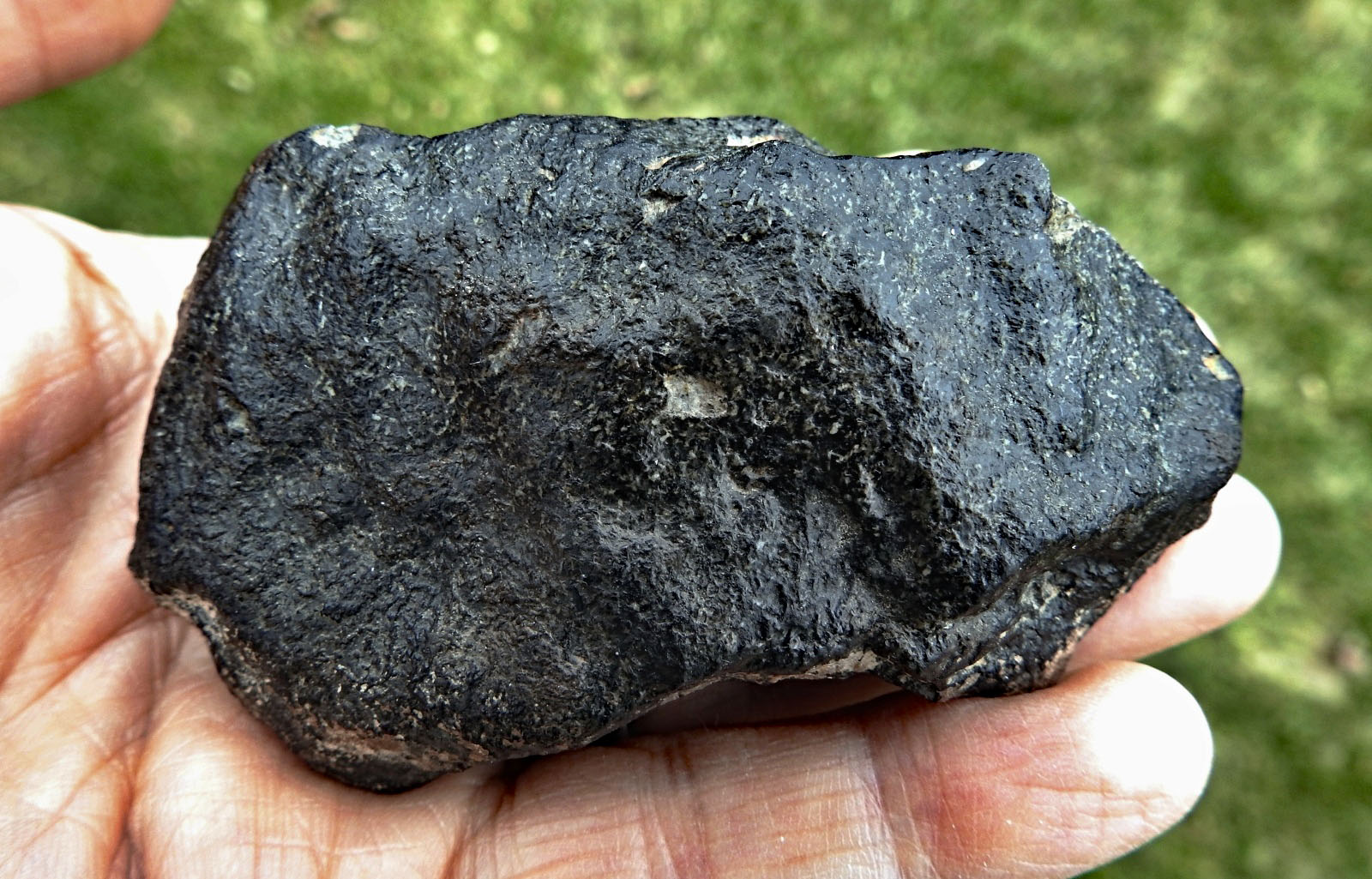|
Roll Overs:
#1
#2
#3
#4
#5
#6
#7
#8
#9
#10
|

|
|
Copyright (c) Steve Brittenham.
|
230 grams. Martian (shergottite)
TKW 8 kg. Fall not observed. Found 2011 in Morocco.
  
Steve writes:
NWA 6963 was first purchased by A. Habibi as three pieces that fit together into a single 83 gram stone. It exhibited minimal surface weathering and shiny dark fusion crust covering most of its exterior. Since then, more pieces have been found – likely totaling over 8 kg.
Originally classified as a Martian basaltic shergottite by UNM’s Dr. Carl Agee, its quartz-alkali feldspar intergrowth instead might suggest a late-stage granitic melt; as a consequence, some scientists now believe it to be a rarer gabbroic shergottite, having solidified at a greater depth than originally thought.
The individual in today’s post (Photos 1 and 2) weighs 230 grams and exhibits glossy fusion crust with microscopic bubbles (Photo 3). While the crust looks black under typical indoor lighting, in direct sunlight, it has a faint olive-colored tint caused by localized areas of green that are more obvious under the microscope (Photo 4). A broken window (Photo 5) shows its grainy interior texture and also some subtle hints of green.
I originally had a small slice of NWA 6963 cut from a different stone, but at the recent Denver show, I was lucky enough to find a larger 5.2 gram full slice (Photo 6) comparable in length to my complete piece. This larger slice also shows obvious variations in texture and color, as well as displaying fusion crust around the edges and a nice shock melt vein (Photo 7).
NWA 6963 is different from Zagami in several ways, including having the highest REE and the lowest Al2O3 content of any basaltic shergottite found before it. Conversely, NWA 6963 is similar to Zagami in that both represent a partial pyroxene cumulate. So because I don’t have a thin section of NWA 6963, this Gigapan link to my Zagami thin section offers at least some idea of NWA 6963’s petrology.
For comparison, this next link shows an actual NWA 6963 thin section and allows the viewer to see it (albeit with lower magnification) using white, polarized, or reflected light (click on “VIEW MICROSCOPE”, then pick the kind of image you want to see at the lower left of the new screen). Plus, clicking on one of the numbers will take you to another screen showing simultaneous virtual white light and xpol views; there, you can rotate a virtual polarizer by holding down the left mouse button while moving the mouse in a circular motion.
And for comparison, you can also view their Zagami thin section here.
Finally, Photos 8 and 9 show crossed-eyes 3D images of different sides of the 230 gram individual, with an alternate rotation of Photo 9’s bottom image presented as a 3D red-cyan anaglyph in Photo 10. (For Photos 8 and 9, please refer to Paul’s advice on my 10/29/20 Aguas Zarcas MPOD regarding using smaller views to more easily see the crossed-eyes 3D images.)
And sorry Chauncey (see comments for 10/29/20) – great suggestion, but no parallel eye 3D images yet. I do plan to look into how to create those too, but I personally can’t do them to be able to subsequently check before posting.
Click to view larger photos #1 #2 #3 #4 #5 #6 #7 #8 #9 #10
|
| |
Chauncey Walden
11/4/2020 11:09:17 AM |
Beautiful specimens. Steve. You already have the images necessary for parallel viewing in the red/cyan pair. The "blue" one is the right eye view and the "red" one is the left eye view. Leave off the color filters and the overlay and present the 2 images separately - right eye on the right and left eye on the left. Just like the old stereopticon images. Speaking of old, I've been making 3D images for nearly 60 years - 3D cameras, single cameras (35mm, medium format, digital), normal and macro, printed pairs, hand viewers, and projected. |
Scott McGregor
11/3/2020 11:59:52 AM |
Wow, that's a lot of Mars! Thanks for taking the time to make the 3D pics for us. |
Steve Brittenham
11/3/2020 10:07:41 AM |
Hi Benjamin. You're right to wonder. When I got it, it definitely showed much more weathering. I spent a lot of time under the microscope cleaning it up (I should have submitted before and after pictures!). There are areas in the fusion crust that actually had etched to a matte finish under some of the terrestrial minerals. You can get a hint of that in the Photo 3, but the lower left patch in Photo 2 is a bigger example. |
Kenneth Regelman
11/3/2020 9:26:16 AM |
Beautiful **** |
Benjamin P. Sun
11/3/2020 1:24:14 AM |
wow Nice specimen! It looks relatively fresh. I wonder.. |
Roberto Vargas
11/3/2020 12:24:47 AM |
Wow 😮 |
| |
|